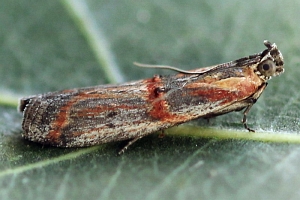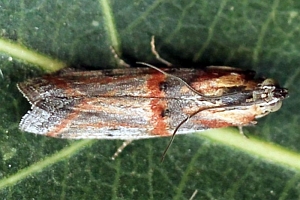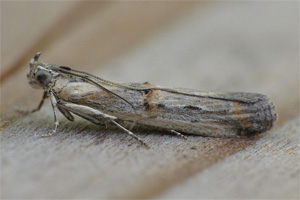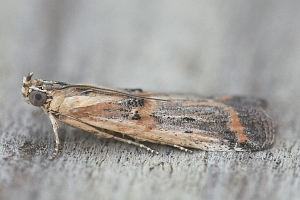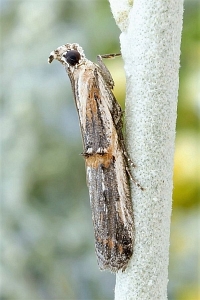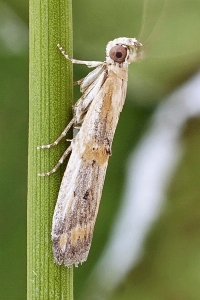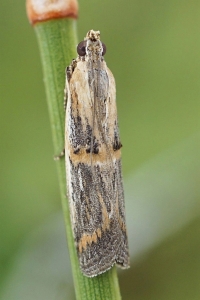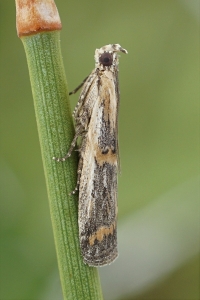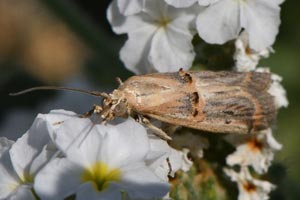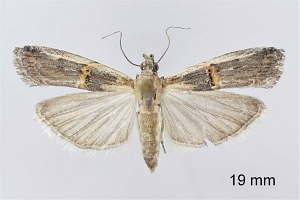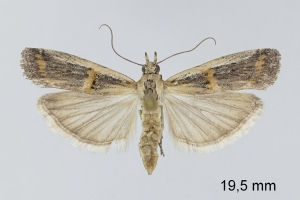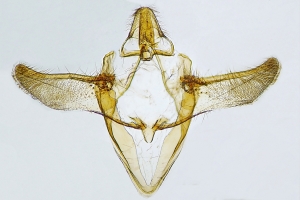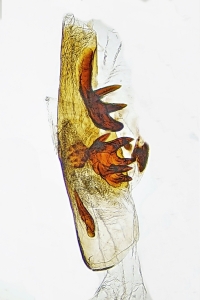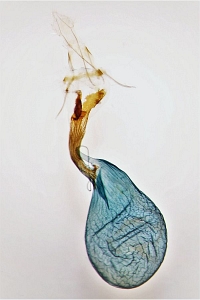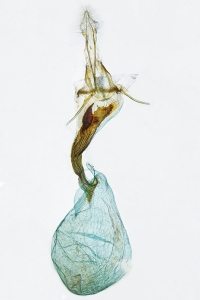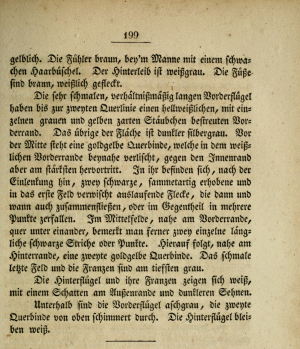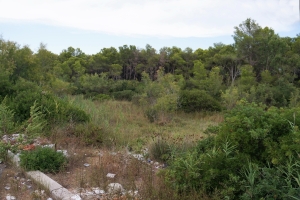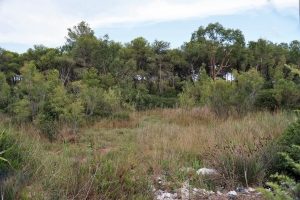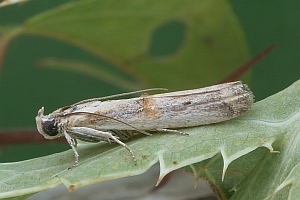
Falter

Männchen

Weibchen
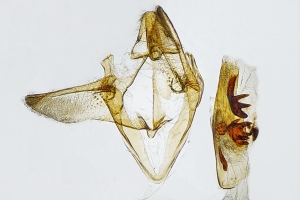
Männchen

Weibchen
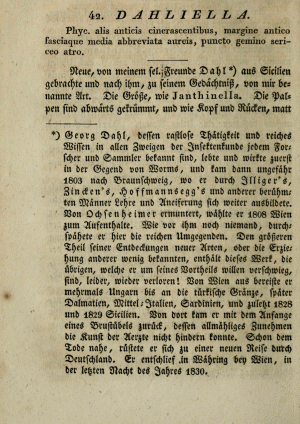
Erstbeschreibung
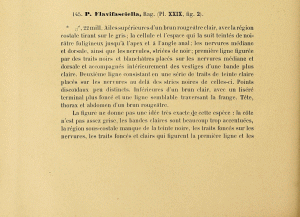
Beschreibung als Psorosa flavifasciella
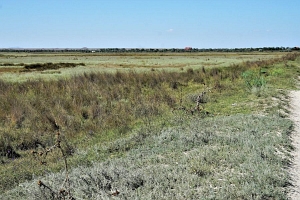
Habitat
Inhalt
1. Lebendfotos
1.1. Falter
1: Bulgarien, Umg. Petritsch, Hügellandschaft mit verwilderten Gärten, ca. 200 m, 21. Juli 2012, Lichtfang (leg., gen. det. & Foto: Friedmar Graf)Forum
2-3: Russland, Gebiet Astrachan, Bezirk Akhtubinsky, Dorf Bolhuny (E 46°17,796’ N 47°58,472’), am Licht, 21. September 2013 (fot.: Andrey Ponomarev), det. Vladimir SavchukForum
4: Frankreich, Alpes-de-Haute-Provence, Niozelles, Campingplatz, 380 m, 30. August 2015, am Licht (fot. & det.: Ursula Beutler, conf. Helmut Deutsch)Forum
5-6: Frankreich, Corse-du-Sud, Porte-Veccio, Piccovaggia, ca. 60 m, Lichtfang, 18. August 2018 (det. & fot.: Jens Philipp), conf. Friedmar GrafForum
7: ♀, Rumänien, Dobrudscha, Constanta, Marschland östlich Istria, - 2 m, 44°32'28.5"N 28°45'37.5"E , 18. August 2019, am Licht (leg., gen. det. & fot.: Friedmar Graf)Forum
8-10: ♂, Italien, Basilikata, Umgebung Metaponto, Strandnähe, 1 m, 40.349782, 16.819725, 16. August 2020, am Licht (leg., gen. det. & fot.: Friedmar Graf), Referenz: Slamka (2019) Pyraloidea of Europe 4, ♀♂ Gen. Fig. 72Forum
11: Griechenland (Festland und festlandsnahe Inseln), Zentralmakedonien, nahe Doirani, Grasland, 150 m, 6. September 2024, Tagfund (Foto: Theodosis Mamais)Forum
2. Diagnose
2.1. Männchen
1-2: ♂, Daten siehe Etikett (fot.: Egbert Friedrich), det. Uwe Büchner
3-4: ♂, Daten siehe Etikett (fot.: Egbert Friedrich), det. Uwe Büchner
5: ♂, Kroatien, Umg. Budimir, 430 m, 14. August 2001, Lichtfang (leg., gen. det. & Foto: Friedmar Graf)Forum
6: ♂, Italien, Basilikata, Umgebung Metaponto, Strandnähe, 1 m, 40.349782, 16.819725, 16. August 2020, am Licht (leg., gen. det. & fot.: Friedmar Graf), Referenz: Slamka (2019) Pyraloidea of Europe 4, ♀♂ Gen. Fig. 72Forum
2.2. Weibchen
1: ♀, Italien, Apulien, Umg. Tarent, ca. 100 m, 28. Juli 2006, Lichtfang (leg., gen. det. & Foto: Friedmar Graf)Forum
2: ♀, Rumänien, Dobrudscha, Constanta, Marschland östlich Istria, - 2 m, 44°32'28.5"N 28°45'37.5"E , 18. August 2019, am Licht (leg., gen. det. & fot.: Friedmar Graf)Forum
3: ♀, Italien, Basilikata, Umgebung Metaponto, Strandnähe, 1 m, 40.349782, 16.819725, 16. August 2020, am Licht (leg., gen. det. & fot.: Friedmar Graf), Referenz: Slamka (2019) Pyraloidea of Europe 4, ♀♂ Gen. Fig. 72Forum
2.3. Genitalien
2.3.1. Männchen
1-3: ♂, Italien, Basilikata, Umgebung Metaponto, Strandnähe, 1 m, 40.349782, 16.819725, 16. August 2020, am Licht (leg., gen. det. & fot.: Friedmar Graf), Referenz: Slamka (2019) Pyraloidea of Europe 4, ♀♂ Gen. Fig. 72Forum
2.3.2. Weibchen
1: Genitalpräparat des oben abgebildeten weiblichen Falterbelegs 1, Daten siehe dort (Präparation, det. & Foto: Friedmar Graf)Forum
2: ♀, Rumänien, Dobrudscha, Constanta, Marschland östlich Istria, - 2 m, 44°32'28.5"N 28°45'37.5"E , 18. August 2019, am Licht (leg., gen. det. & fot.: Friedmar Graf)Forum
3: ♀, Italien, Basilikata, Umgebung Metaponto, Strandnähe, 1 m, 40.349782, 16.819725, 16. August 2020, am Licht (leg., gen. det. & fot.: Friedmar Graf), Referenz: Slamka (2019) Pyraloidea of Europe 4, ♀♂ Gen. Fig. 72Forum
2.4. Erstbeschreibung
1-2: Treitschke (1832: 198-199) [nach Copyright-freien Scans auf www.biodiversitylibrary.org]
2.5. Beschreibung als Psorosa flavifasciella
1-3: Hampson in Ragonot (1901: 106-107 + pl. XXIX fig. 2) [nach Copyright-freien Scans auf www.biodiversitylibrary.org]
4. Weitere Informationen
4.1. Etymologie (Namenserklärung)
Nach dem deutschen Entomologen Georg Dahl [Treitschke (1832: 198, Fussnote)].
4.2. Andere Kombinationen
- Phycis dahliella Treitschke, 1832 [Originalkombination]
4.3. Synonyme
- Phycis bivitella Duponchel, 1836
- Phycis bifasciata Duponchel, 1836
- Psorosa flavifasciella Hampson, 1901 [K+R-Nr. 05777]
4.4. Taxonomie
Leraut (2014) stellt Psorosa flavifasciella [K+R-Nr. 05777] ohne jegliche Begründung als "syn. nov." in die Synonymie von Psorosa dahliella. Slamka (2019: 73) akzeptiert das, schreibt dazu aber auch nur: "Psorosa flavifasciella Ragonot & Hampson, 1901 was synonymized with dahliella by Leraut (2014); it has a very broad ochreous post-medial line (band) on the forewings (type in coll. NHML)." So wie das klingt, hat er dieses Typusexemplar gesehen.
4.5. Faunistik
Locus typicus ist Sizilien. Die Art ist im Mediterran-Raum weit verbreitet.
Locus typicus des Synonyms P. flavifasciella ist Cintra (Portugal) - jenes Taxon wurde auch noch von Spanien genannt.
(Autor: Erwin Rennwald)
4.6. Literatur
- Leraut, P. (2014): Moths of Europe. Volume 4. Pyralids 2. - 441 S.; Verrières-le-Buisson (N.A.P Editions).
- Beschreibung als Psorosa flavifasciella: Ragonot, E. L. (1901): Monographie des Phycitinae et des Galleriinae. — Mémoires sur les Lépidoptères 8. I-XLI, 1-602, pl. XXIV-LVII. Saint-Pétersbourg.
- Erstbeschreibung: Treitschke, F. (1832): Die Schmetterlinge von Europa 9 (1): I-VIII, 1-272. Leipzig (Ernst Fleischer).




![Vorkommen in Russland (europäischer Teil bis Manytsch-Niederung) [Sinev (2021)]](/res/img/flag/ru.gif)
![Vorkommen in der Ukraine (ohne Halbinsel Krim) [Karolinskiy, Demyanenko, Guglya, Zhakov, Kavurka & Mushinskiy (2018)]](/res/img/flag/ua.gif)
![Vorkommen auf der Krim [Sinev (2021)]](/res/img/flag/ua-kri.gif)

![Vorkommen in Ungarn [Pastorális et. al. (2018): A Magyarországon előforduló molylepke-fajok névjegyzéke]](/res/img/flag/hu.gif)
![Vorkommen in Frankreich (europäisches Territorium ohne Korsika) [Vandromme et al. (2020): Liste systématique et taxinomique des Lépidoptères de France]](/res/img/flag/fr.gif)
![Vorkommen auf Korsika [Vandromme et al. (2020): Liste systématique et taxinomique des Lépidoptères de France]](/res/img/flag/fr-cor.png)
![Vorkommen in Spanien (Festland) [Vives Moreno A. (2014)]](/res/img/flag/es.gif)
![Vorkommen in Portugal (Festland) [Corley (2015): Lepidoptera of Continental Portugal]](/res/img/flag/pt.gif)
![Vorkommen in Italien (Festland und kleine festlandsnahe Inseln) [Bassi et al. (1995): Checklist delle Specie della Fauna Italiana 87]](/res/img/flag/it.gif)
![Vorkommen auf Sardinien [Bassi et al. (1995): Checklist delle Specie della Fauna Italiana 87]](/res/img/flag/it-sar.png)
![Vorkommen in Sizilien [Bassi et al. (1995): Checklist delle Specie della Fauna Italiana 87]](/res/img/flag/it-sic.png)
![Einzelnachweis in Malta [Asselbergs, Seguna & Sammut (2008)]](/res/img/flag/mt.gif)
![Vorkommen in Kroatien [Gumhalter (2021)]](/res/img/flag/hr.gif)
![Vorkommen in Bosnien und Herzegowina [Rebel (1904): Lepidopterenfauna der Balkanländer]](/res/img/flag/ba.gif)
![Vorkommen in Nordmazedonien [Klimesch (1968); Plant, Beshkov, Jakšić & Nahirnić (2017)]](/res/img/flag/mk.gif)
![Vorkommen in Albanien [Plant & Jakšić (2018)]](/res/img/flag/al.gif)
![Vorkommen in Rumänien [Rákosy L. & M. Goia (2021): Lepidopterle din România: lista sistematică şi distribuţie]](/res/img/flag/ro.gif)

![Vorkommen in Griechenland (Festland und festlandsnahe Inseln) [Plant & Jakšić (2018)]](/res/img/flag/gr.png)
![Vorkommen auf Kreta [https://www.inaturalist.org/observations/207427207 (inaturalist.org/projects/moths-of-crete (Stand 24.12.2024): 6 Beobachtungen), in Slamka (2019: 27 [Pyr. Eur. Vol. 4]) fehlend]](/res/img/flag/gr.gif)
![Vorkommen im europäischen Teil der Türkei [Plant & Jakšić (2018)]](/res/img/flag/tr.gif)
![Vorkommen in Syrien [Slamka (2019)]](/res/img/flag/sy.gif)
![Vorkommen in Irak [Slamka (2019)]](/res/img/flag/iq.gif)
![Vorkommen in Iran [Rajaei & al. (2023)]](/res/img/flag/ir.gif)
![Vorkommen in Usbekistan [Slamka (2019)]](/res/img/flag/uz.gif)
![Vorkommen in Turkmenistan [Slamka (2019)]](/res/img/flag/tm.gif)
![Vorkommen in Marokko [Slamka (2019)]](/res/img/flag/ma.gif)
![Vorkommen in Ägypten (gesamtes Territorium) [Slamka (2019)]](/res/img/flag/eg.gif)
![Vorkommen im europüischen und/oder asiatischen Teil von Kasachstan [Slamka (2019)]](/res/img/flag/kz.gif)
